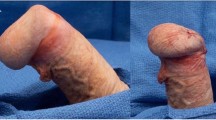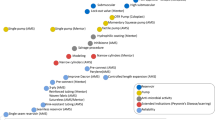Abstract
Penile implants hold a major position in the treatment algorithm for patients with erectile dysfunction who find medications and vacuum erection devices ineffective or unsatisfactory. As with any surgical procedure, adverse events may occur. The infection rate associated with implant placement has been lowered to the range of 1 % or less due to multifactorial improvements including no-touch techniques, the use of antibiotic-coated devices, and improved quality measures in the operating room. Urologists have been proactive in employing techniques and procedures which minimize loss of erectile length, hence enhancing patient satisfaction. Flat reservoirs have been developed and techniques of placing these to avoid problems in the space of Retzius have reduced complication rates as well. Device reliability has improved to the point that penile implants are among the most durable mechanical surgical products that contribute to patient and partner satisfaction, which is by far the greatest among all the treatments of erectile dysfunction.
Similar content being viewed by others
References
Papers of particular interest, published recently, have been highlighted as: • Of importance •• Of major importance
Mulcahy JJ. Penile prosthesis infection: progress in prevention and treatment. Curr Urol Rep. 2010;11:400–4.
Mulcahy JJ. Surgical management of penile prosthesis complications. Int J Impot Res. 2000;12:108–11.
Darouiche RO, Wall MJ, Kamal MF, et al. Chlorhexidine-alcohol versus povidone-iodine for surgical site antisepsis. N Engl J Med. 2010;362:18–26. This study shows that a chlorhexidine-alcohol skin prep is 40% more effective in reducing surgical site infection when compared with the standard povidone-iodine prep.
Eid F. No-touch technique. J Sex Med. 2011;8:5–8. Dr Eid’s compulsive no-skin-touch implantation technique series has perhaps the lowest infection rate for penile implant placement on record. This reinforces the concept that infectious organisms are introduced via the wound and not by hematogenous spread.
Siegrist TC, Kwon EO, Fracchia JA, Eid JF. No touch technique: a novel technique for reducing postoperative infections in patients receiving multicomponent inflatable penile prostheses. J Urol. 2008;179:404.
Wilson SK, Salem EA, Costerton W. Anti-infection dip suggestions for the Coloplast Titan inflatable penile prosthesis in the era of the infection retardant coated implant. J Sex Med. 2011;8:2647–54.
Carson CC. Efficacy of antibiotic impregnation of inflatable penile prostheses in decreasing infection in original implants. J Urol. 2004;171:1611–4.
Richardson B, Caire A, Hellstrom W. Retrospective long-term analysis of Titan hydrophilic coating: positive reduction of infection compared to non-coated device. J Sex Med. 2010;7:28.
Dhabuwala C, Sheth S, Zamzow B. Infection rates of rifampin/gentamicin-coated titan Coloplast implants. Comparison with Inhibizone-Impregnated AMS penile implants. J Sex Med. 2011;8:315–20.
Köhler TS, Modder JK, Dupree JM, Bush NC, McVary KT. Malleable implant substitution for the management of penile prosthesis pump erosion: a pilot study. J Sex Med. 2009;6:1474–8. The less complicated approach of placing semirigid spacer rods only following salvage irrigations is to be recommended especially where there is severe inflammation in the scrotum.
Swords K, Martinez DR, Lockhart J, Carrion R. A preliminary report on the usage of an intracorporal antibiotic cast with synthetic high purity CaSO4 for the treatment of infected penile implant. J Sex Med. 2013;10:1162–9.
Montorsi F, Rigatti P, Carmignani G, Corbu C, Campo B, Ordesi G, et al. AMS three-piece inflatable implants for erectile dysfunction: a long-term multi-institutional study in 200 consecutive patients. Eur Urol. 2000;37:50–5.
Deveci S, Martin D, Parker M, Mulhall JP. Penile length alterations following penile prosthesis surgery. Eur Urol. 2007;51:1128–31.
Sellers T, Dineen M, Salem EA, Wilson SK. Vacuum preparation, optimization of cylinder length and postoperative daily inflation reduces complaints of shortened penile length following implantation of inflatable penile prosthesis. Adv Sex Med. 2013;03:14–8. For the motivated patient who has a strong desire to maintain as much erectile length as possible after implant placement this regimen is effective and strongly recommended.
Henry G, Houghton L, Culkin D, Otheguy J, Shabsigh R, Ohl DA. Comparison of a new length measurement technique for inflatable penile prosthesis implantation to standard techniques: outcomes and patient satisfaction. J Sex Med. 2011;8:2640–6.
Wilson SK, Delk JR, Mulcahy JJ, Cleves M, Salem EA. Upsizing of inflatable penile implant cylinders in patients with corporal fibrosis. J Sex Med. 2006;3:736–42.
Borges F, Hakim L, Kline C. Surgical technique to maintain penile length after insertion of an inflatable penile prosthesis via infrapubic approach. J Sex Med. 2006;3:550–3.
Miranda-Sousa A, Keating M, Moreira S, Baker M, Carrion R. Concomitant ventral phalloplasty during penile implant surgery: a novel procedure that optimizes patient satisfaction and their perception of phallic length after penile implant surgery. J Sex Med. 2007;4:1494–9.
Caso J, Keating M, Miranda-Sousa A, Carrion R. Ventral phalloplasty. Asian J Androl. 2008;10:155–7.
Hakky TS, Suber J, Henry G, Smith D, Bradley P, Martinez D, et al. Penile enhancement procedures with simultaneous penile prosthesis placement. Adv Urol. 2012;2012:314612. This ventral phalloplasty is a simple procedure which usually adds little time and morbidity to the implant procedure and can enhance patient satisfaction significantly.
Pestana IA, Greenfield JM, Walsh M, Donatucci CF, Erdmann D. Management of “buried” penis in adulthood: an overview. Plast Reconstr Surg. 2009;124:1186–95.
Levine LA, Benson J, Hoover C. Inflatable penile prosthesis placement in men with Peyronie’s disease and drug-resistant erectile dysfunction: a single-center study. J Sex Med. 2010;7:3775–83.
Sansalone S, Garaffa G, Djinovic R, Egydio P, Vespasiani G, Miano R, et al. Simultaneous penile lengthening and penile prosthesis implantation in patients with Peyronie’s disease, refractory erectile dysfunction, and severe penile shortening. J Sex Med. 2012;9:316–21.
Rolle L, Ceruti C, Timpano M, Sedigh O, Destefanis P, Galletto E, et al. A new, innovative, lengthening surgical procedure for Peyronie’s disease by penile prosthesis implantation with double dorsal-ventral patch graft: the “sliding technique”. J Sex Med. 2012;9:2389–95.
Garber BB, Morris A. Intravesical penile implant reservoir: case report, literature review, and strategies for prevention. Int J Impot Res. 2012;25:41–4.
Perito PE, Wilson SK. Traditional (retroperitoneal) and abdominal wall (ectopic) reservoir placement. J Sex Med. 2011;8:656–9.
Perito PE. Ectopic reservoir placement - no longer in the space of Retzius. J Sex Med. 2011;8(9):2395–8. The techniques described for reservoir placement minimize the chance of complications which could be catastrophic, such as iliac vessel injury.
Wilson SK, Henry GD, Delk Jr JR, Cleves MA. The mentor Alpha 1 penile prosthesis with reservoir lock-out valve: effective prevention of auto-inflation with improved capability for ectopic reservoir placement. J Urol. 2002;168:1475–8.
Morey AF, Cefalu CA, Hudak SJ. High submuscular placement of urologic prosthetic balloons and reservoirs via transscrotal approach. J Sex Med. 2013;10:603–10.
Chung E, Solomon M, Deyoung L, Brock GB. Comparison between AMS 700 CX and Coloplast Titan Inflatable Penile Prosthesis for Peyronie's disease treatment and remodeling: clinical outcomes and patient satisfaction. J Sex Med. 2013;10(11):2855–60. This study demonstrates that the mechanical reliability and patient satisfaction with the 3-piece inflatable penile implant is similar with both vendors products.
DiBlasio CJ, Kurta JM, Botta S, Malcolm JB, Wan JY, Derweesh IH, et al. Peyronie's disease compromises the durability and component-malfunction rates in patients implanted with an inflatable penile prosthesis. BJU Int. 2010;106(5):691–4.
Akin-Olugbade O, Parker M, Guhring P, Mulhall J. Determinants of patient satisfaction following penile prosthesis surgery. J Sex Med. 2006;3(4):743–8.
Menard J, Tremeaux JC, Faix A, Pierrevelcin J, Staerman F. Erectile function and sexual satisfaction before and after penile prosthesis implantation in radical prostatectomy patients: a comparison with patients with vasculogenic erectile dysfunction. J Sex Med. 2011;8(12):3479–86.
Al-Najar A, Naumann CM, Kaufmann S, Steinbach-Jensch A, Hamann MF, Junemann KP, et al. Should being aged over 70 years hinder penile prosthesis implantation? BJU Int. 2009;104(6):834–7.
Gittens P, Moskovic DJ, Avila Jr D, Chandrashekar A, Khera M, Lipshultz LI. Favorable female sexual function is associated with patient satisfaction after inflatable penile prosthesis implantation. J Sex Med. 2011;8(7):1996–2001.
Bettocchi C, Palumbo F, Spilotros M, Lucarelli G, Palazzo S, Battaglia M, et al. Patient and partner satisfaction after AMS inflatable penile prosthesis implant. J Sex Med. 2010;7(1 Pt 1):304–9.
Kava BR, Yang Y, Soloway CT. Efficacy and patient satisfaction associated with penile prosthesis revision surgery. J Sex Med. 2007;4(2):509–18.
Mulcahy JJ. Long-term experience with salvage of infected penile implants. J Urol. 2000;163(2):481–2.
Wilson SK. Reimplantation of inflatable penile prosthesis into scarred corporeal bodies. Int J Impot Res. 2003;15 Suppl 5:S125–8.
Mulcahy JJ, Austoni E, Barada JH, Choi HK, Hellstrom WJ, Krishnamurti S, et al. The penile implant for erectile dysfunction. J Sex Med. 2004;1(1):98–109.
Wilson SK, Delk JR, Salem EA, Cleves MA. Long-term survival of inflatable penile prostheses: single surgical group experience with 2,384 first-time implants spanning two decades. J Sex Med. 2007;4(4 Pt 1):1074–9.
Salem EA, Wilson SK, Neeb A, Delk JR, Cleves MA. Mechanical reliability of AMS 700 CX improved by parylene coating. J Sex Med. 2009;6(9):2615–20.
Enemchukwu EA, Kaufman MR, Whittam BM, Milam DF. Comparative revision rates of inflatable penile prostheses using Woven Dacron(R) Fabric cylinders. J Urol 2013.
Kim DS, Yang KM, Chung HJ, Choi HM, Choi YD, Choi HK. AMS 700CX/CXM inflatable penile prosthesis has high mechanical reliability at long-term follow-up. J Sex Med. 2010;7(7):2602–7.
Dhar NB, Angermeier KW, Montague DK. Long-term mechanical reliability of AMS 700CX/CXM inflatable penile prosthesis. J Urol. 2006;176(6 Pt 1):2599–601. discussion 601.
Falcone M, Rolle L, Ceruti C, Timpano M, Sedigh O, Preto M, et al. Prospective analysis of the surgical outcomes and patients' satisfaction rate after the AMS Spectra penile prosthesis implantation. Urology. 2013;82(2):373–6.
Krauss DJ, Lantinga LJ, Carey MP, Meisler AW, Kelly CM. Use of the malleable penile prosthesis in the treatment of erectile dysfunction: a prospective study of postoperative adjustment. J Urol. 1989;142(4):988–91.
Montorsi F, Guazzoni G, Bergamaschi F, Rigatti P. Patient-partner satisfaction with semirigid penile prostheses for Peyronie's disease: a 5-year followup study. J Urol. 1993;150(6):1819–21.
Salama N. Satisfaction with the malleable penile prosthesis among couples from the Middle East–is it different from that reported elsewhere? Int J Impot Res. 2004;16(2):175–80.
Levine LA, Estrada CR, Morgentaler A. Mechanical reliability and safety of, and patient satisfaction with the Ambicor inflatable penile prosthesis: results of a 2 center study. J Urol. 2001;166(3):932–7.
Lux M, Reyes-Vallejo L, Morgentaler A, Levine LA. Outcomes and satisfaction rates for the redesigned 2-piece penile prosthesis. J Urol. 2007;177(1):262–6.
Compliance with Ethics Guidelines
Conflict of Interest
Dr. Andrew Kramer, Dr. Justin L. Parker, Dr. Paul E. Perito, Dr. Richard Bryson, and Dr. Meagan Dunne each declare no potential conflicts of interest.
Dr. John J. Mulcahy received honoraria, payment for the development of educational presentations including service on speakers’ bureaus, and travel/accommodations expenses covered or reimbursed from AMS and Coloplast.
Dr. William O. Brant is consultant for and has had travel/accommodations expenses covered or reimbursed from AMS and Coloplast. Dr. Brant receives royalties from Smith’s Urology and UpToDate. Dr. Brant has received grants from AMS and The Joe W. and Dorothy Dorsett Brown Foundation. Dr. Brant gave expert testimony on behalf of COPIC Medical Insurance.
Dr. Jeremy B. Myers is a board member for International Volunteers in Urology.
Human and Animal Rights and Informed Consent
This article does not contain any studies with human or animal subjects performed by any of the authors.
Author information
Authors and Affiliations
Corresponding author
Additional information
This article is part of the Topical Collection on Men's Health
Rights and permissions
About this article
Cite this article
Mulcahy, J.J., Kramer, A., Brant, W.O. et al. Current Management of Penile Implant Infections, Device Reliability, and Optimizing Cosmetic Outcome. Curr Urol Rep 15, 413 (2014). https://doi.org/10.1007/s11934-014-0413-6
Published:
DOI: https://doi.org/10.1007/s11934-014-0413-6




